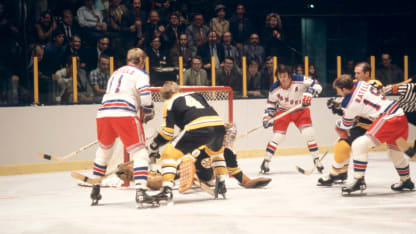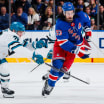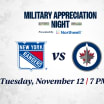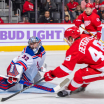SPECIAL TICKET PACKAGE: Join us on 12/2 for an exclusive pre-game meet & greet featuring the GAG Line and then witness Rangers history when Vic Hadfield's #11 is raised to the rafters at The Garden. CLICK HERE TO GET TICKETS »
Vic Hadfield describes himself this way: "I am a Ranger through and through."
He was the captain of the Rangers in the 1970s, the first 50-goal scorer in the history of the franchise, the ultimate teammate - and on Dec. 2, his No. 11 will take its place among the Rangers legends in the Garden rafters.
NYRangers.com will present 11 of the great moments of Hadfield's career, 11 snapshots of the Blueshirts' legendary left winger, 11 for No. 11 - counting down to the celebration of Vic Hadfield Night presented by Budweiser before the Blueshirts take on the Winnipeg Jets on Dec. 2 at Madison Square Garden.
They are three of the greatest players ever to wear the Blueshirt, but sometimes you don't even need to say their names. Three little words, and every Ranger fan knows exactly who you're talking about.
The GAG Line.
They last skated together more than 40 years ago, but have always been joined to one another in Rangers lore. And on Sunday night, when the Rangers retire Vic Hadfield's No. 11, the Goal-A-Game Line will be together once more, reunited for all time in the rafters of Madison Square Garden.
As it was on the ice, Vic Hadfield will be the final piece of the puzzle to bring it all together.
But where did it begin? To hear it from Emile Francis, the man who put the combination together in the first place, this legendary line was not so much a stroke of hockey genius, but was born out of something more innate - specifically, a survival instinct. Francis had two of the top players in the sport in Jean Ratelle and Rod Gilbert, but he needed someone to do a little looking after them.
Vic Hadfield Legendary Moments No. 2: Francis Forms the GAG Line

"Most people didn't like to play against Vic, because he had a bad attitude," Gilbert said. "You know what I mean?"
Francis traces the GAG Line back to a game at Maple Leaf Gardens in 1968 - or more accurately, to the ride home afterward.
The Leafs "had won a couple of Stanley Cups around then, and this game, we were giving them too good of a game I guess," Francis recalled to NYRangers.com. "(Punch) Imlach was the coach and he put out Eddie Shack."
Shack had begun his career with the Rangers, but was traded to Toronto in 1960 and was often among the League leaders in penalty minutes during his nine seasons as a Maple Leaf. They wrote a song about him: "Clear the Track, Here Comes Shack."
"He puts out Shack, and I had out Camille Henry on left wing, and Ratelle in the middle, and Rod Gilbert on the right side. Camille Henry weighed about 135 pounds. Was really an artist around the net, I've never seen a guy who could deflect shots like he could. But I mean he weighed 135 pounds, you know?
"Shack was out there for about 20 seconds and all three of them are laying on the ice, he hit all three of them. Frank Paice, our trainer, yells at me, 'Who should I go to first?' I said, 'Ratelle!'
"I was so pissed off that night on the way home. I said, 'This is going to change. This is going to be the end of that.' So what I did was I put Vic Hadfield to play with Ratelle and Gilbert."
What Francis also did was create into one of the legendary lines in Rangers history - more so than any since the Bread Line in the franchise's formative years - as well as one of the most prolific forward units in National Hockey League history. The trio stayed together through 1974, and in the 1971-72 season enjoyed its finest season of all. They combined for 312 points that year - Ratelle (109 points), Hadfield (106) and Gilbert (97) were Nos. 3, 4 and 5 in NHL scoring, behind only Phil Esposito and Bobby Orr of Boston. Hadfield became the first Ranger ever to score 50 goals in a season, while Gilbert scored 43 and Ratelle 46 in only 63 games before going down in March to the fractured ankle that dimmed the Rangers' Stanley Cup hopes.
"We would have all scored 50 goals that year if Ratelle doesn't get hurt," Gilbert said. "Easy."
"Boy that would've been something," said Francis.
Gilbert and Ratelle had been playing together since they were growing in Quebec, and had signed together to play junior hockey in Guelph. Francis understood that he was introducing a new element, and not exactly a seasoned goal scorer, onto a line with his two most skilled and close-knit players. Which was kind of the point, and right away the coach could see that Hadfield was going to be a nice fit.
Early in his career, "I couldn't carry the puck in a pail," Hadfield said, but he recalled Francis telling him, "Just play your game, play the way you've been playing. He bumped me up to keep things in order. My role was to be aggressive, get on top of the puck, hound the puck, get in the corners and get the puck. And with the ability of Jean and Rod, they would take it from there."
"Playing with Ratelle I think even I could score the odd goal," Francis joked. "Not only did Ratelle of course help him a lot, but also (Hadfield) helped himself because nobody wanted to tangle with him - he could've stayed in front of the net and not too many guys were too anxious to get at him, you know? He got a lot of room out there, if you know what I mean."
Gilbert said he had been pining for that kind of move up until Francis made it.
"Our line was too light," Gilbert said. "Camille was 130 pounds, and I was like 175 pounds, so was Jean - I mean, our line was too light. If they wanted to goon us, what was going to stop them? … I had to do all the work in the corners, and I'm a goal scorer, and I needed somebody to go into the corners once in a while.
"If somebody was a little too aggressive with Jean or myself, Vic would have a talk with them. Let them know that they were - how to say this? - distracting us."
Among the top five goal scorers in Rangers history, three of them come from the GAG Line: Gilbert (406) and Ratelle (336) are Nos. 1 and 2, and Hadfield No. 5 with 262 goals. It is an historic level of production from one line, and one that likely is relegated to history, given that lines in today's hockey are not kept together as they were in the GAG Line's heyday.
"The game has totally changed. You never see too many games in a row where the lines will be intact - they have different roles now," Hadfield said. In his playing days, "Very, very rarely did they ever break up a line. You'd have good games and you'd have bad games, but they kept the guys together."
As they will do on Sunday at the Garden, where the GAG Line will be together again.
READ MORE: Vic Hadfield Legendary Moments No. 3: "Don't Give It Back!"


















